
Researchers have discovered strange deep-sea tubeworms 36 miles off the North Carolina coast—an animal that has never been observed before in this area of the Atlantic Ocean.
A team from the Deep Search program made the find while exploring several recently identified methane cold seeps— cracks or fissures where hydrocarbon-rich fluid is released from below the seafloor—near Pea Islan. They used a remotely operated vehicle known as Jason, which belongs to the Woods Hole Oceanographic Institution.
Amanda Demopoulos, an ecologist from the U.S. Geological Survey and chief scientist on the expedition, said that a tubeworm popped out "like a jack in a box" while Jason was handling a piece of rock.
"The initial discovery of the tubeworm was very serendipitous," Demopoulos said in a statement. "We were trying to break off a piece of rock for a collection when the worm appeared seemingly out of nowhere. It was hidden from view, buried in a crevice within the larger rock."
After this initial observation, the team investigated another seep in the area, finding more of the tubeworms—which belong to the animal group called vestimentiferan.
These bizarre invertebrates—which are almost plant-like in appearance—inhabit tubular structures that are connected to the seafloor near gas seeps and hydrothermal vents. The tubeworms don't have a digestive system and thus rely on symbiotic bacteria that live inside them for nutrition.
These bacteria convert hydrogen sulfide—a compound that is toxic to humans and smells like rotten eggs—released by vents or seeps into organic molecules that provides food for the worms.
Vestimentiferan tubeworms have been documented in the Gulf of Mexico, parts of the Caribbean, Brazil, West Africa and the Mediterranean, but never in this region of the Atlantic.
"These tubeworms are a significant finding and contribution to our understanding of the biodiversity of the deep sea," Michael Rasser, a marine ecologist with the Bureau of Ocean Energy Management, who also took part in the expedition, said in a statement. "The more we know about these sensitive habitats the better we can ultimately use science to inform any future decisions to ensure their protection."
The cold seeps the team investigated off the North Carolina coast were first identified in 2017 by an autonomous underwater vehicle known as Sentry. They are home to a diverse array of marine life—including several types of fish, such as black-bellied rosefish, snipe eels, hammerhead sharks, manta rays and tuna.
Uncommon Knowledge
Newsweek is committed to challenging conventional wisdom and finding connections in the search for common ground.
Newsweek is committed to challenging conventional wisdom and finding connections in the search for common ground.
About the writer
Aristos is a Newsweek science reporter with the London, U.K., bureau. He reports on science and health topics, including; animal, ... Read more
To read how Newsweek uses AI as a newsroom tool, Click here.








